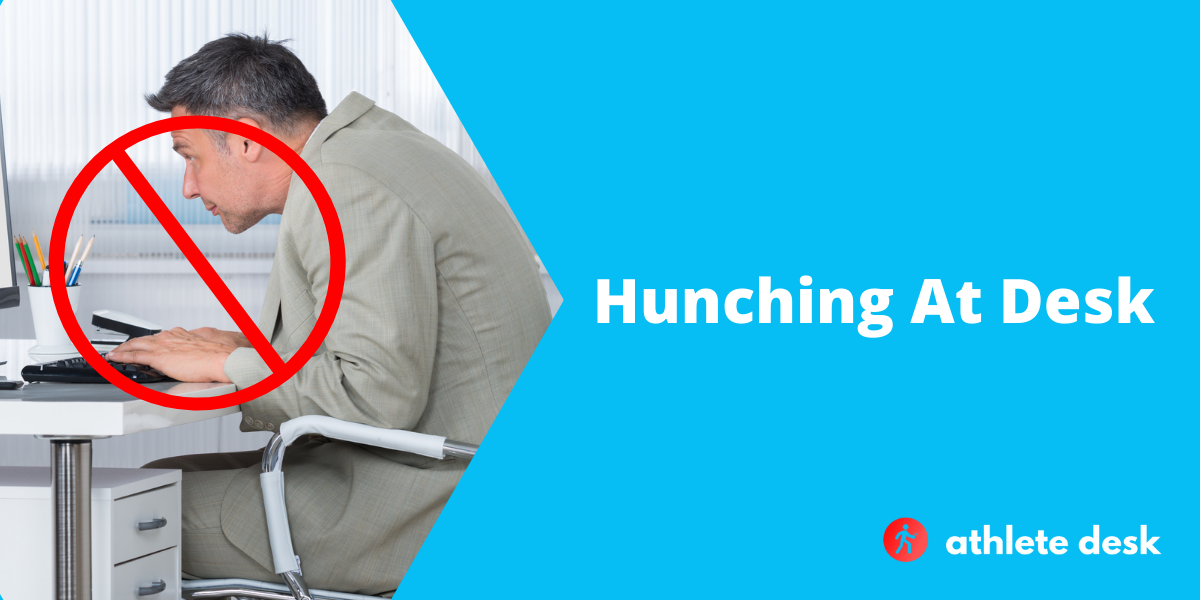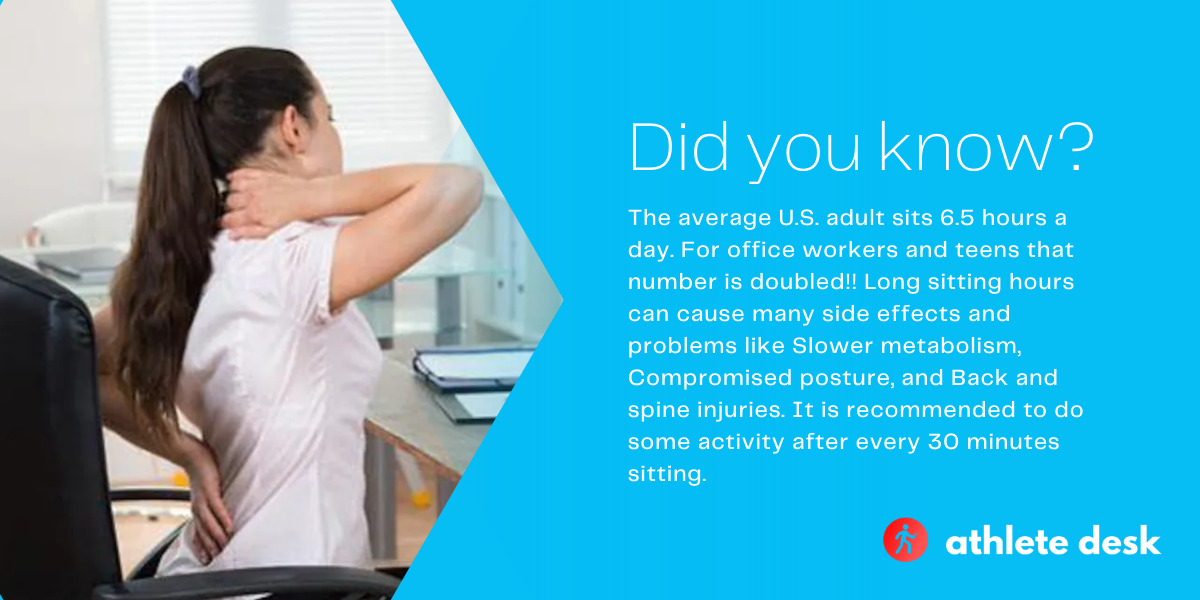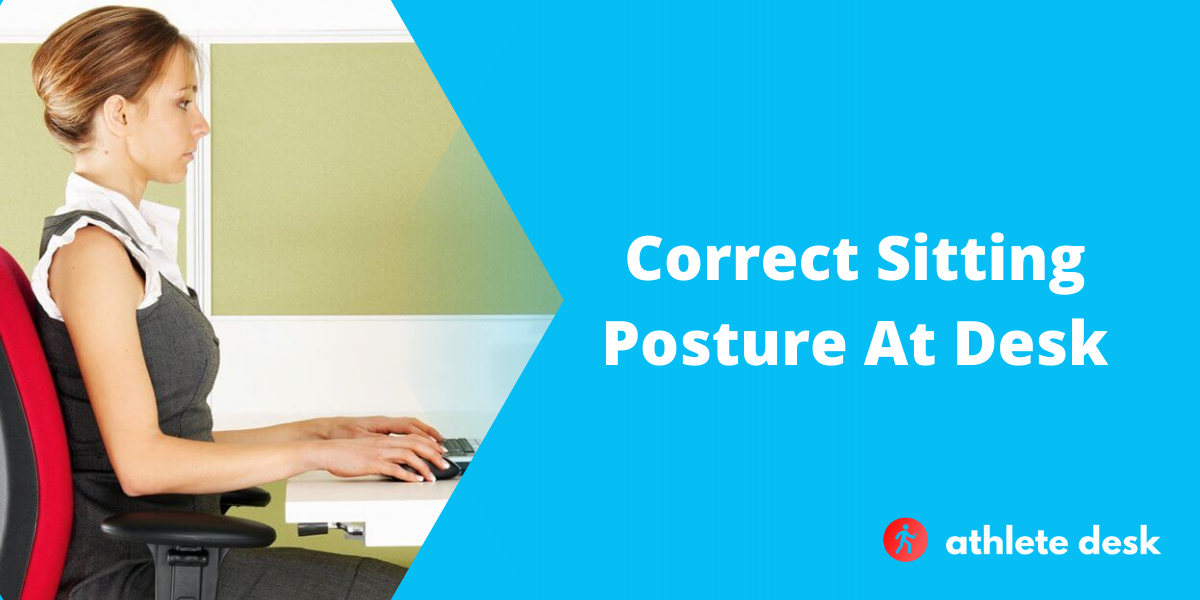Are you interested in the best posture for sitting at a desk? You should be! Sitting at a desk takes up an increasingly large proportion of our day and our posture has never needed more attention because of it.
In this article, we will discuss some of the most asked questions regarding posture such as:
- How do I not hunch?
- How should I sit?
- How long should I sit for?
- What can I do to improve my posture?

What Is The Best Posture For Sitting At a Desk?
We as humans are not designed to sit for extended periods. Our bodies are meant to be moving and active throughout the day. So we are not adapted to having to our increasingly sedentary lifestyles.
Sitting is something that we do not put much thought into. As long as we aren’t in extreme discomfort, most of us just continue to sit as we are.
However, sitting for a long time, as well as sitting incorrectly, can be more damaging to our health than we may realize. We must do what we can to make sitting as healthy as possible, that is why there is a best posture for sitting at a desk.
Read More >> Breakdown Of Drafting Chairs vs Office Chairs
How do I not hunch at my desk?

The most important thing that you can do to avoid hunching is to be aware of your posture. Try to habitually check whether you are hunched over or slouching.
Keep track of any aches and pains in your back and neck as these are the warning signs you need to change the way you sit and stand. Once you are conscious of your poor posture, you begin to correct it.
Poor posture and hunching go far beyond sitting behind a desk. Poor posture has many contributing factors such as the way you stand, the way you sleep, and your exercise regime.
Read More >> Top 5 Best Saddle Chairs with Backrests (2021 Review)
Maintaining the correct spine alignment at all times can improve your quality of life and prevent many health complications.
Exercising the muscles necessary for good posture is the best thing that you can do.
Although there are modern ergonomic inventions to prevent poor posture, most of them are expensive, uncomfortable, and cannot be used at all times.
Doing some simple exercises can strengthen your back and core, improve your posture and take pressure off your spine.
Strengthening certain muscle groups will provide support for your spine, automatically improving your posture.
Here is a YouTube video outlining some great exercises that you can use to improve posture:
How do you sit professionally?
Correct posture displays confidence and professionalism.
Picture an employee slouched over their desk, versus one that has good posture, which one would you consider to be the more professional, productive, and engaged employee?
Body language conveyed by posture communicates a lot about your attitude, experience, and confidence. Hunching suggests that you are apathetic and that you are not alert.
Often small things, like the way you sit, can leave lasting impressions and lead someone into drawing inaccurate conclusions about your work performance.
Employers are becoming aware of the health risks involved with sitting and the importance of sitting correctly.
Not only will comfortable employees have higher morale and productivity, but they will also miss fewer days of work due to sitting-related health problems.
So it is in everyone's best interest for you to have the correct posture.
How long should I sit at my desk?

Studies have shown that taking regular breaks every 30 minutes drastically decreases the adverse health effects caused by sitting.
It has also been proven that workers who take regular breaks have lower cases of lower back pain.
Taking regular breaks can help prevent things like high cholesterol and high blood pressure associated with a sedentary lifestyle.
This study by the American Journal of Physiology shows that it is important to exercise for 3 minutes for every 30 minutes spent sitting to counteract the negative effects of sitting.
This can involve a series of stretches and exercises to loosen and open up your back muscles.
Even a brief walk is beneficial as it increases blood flow and energy levels. Your eyes also get a much-needed rest from focusing on bright screens.
Read More >> Kneeling Chair Desk Height: What’s Best for You?
No matter how good your posture is, the fact is that we are not designed to be sitting behind a desk all day.
So set yourself reminders every 30 minutes to take a short break. Your body and mind will thank you for it.
How should I sit at my desk?

Your desk should be laid out in an ergonomic manner that allows for the correct posture.
It isn’t just the chair that is responsible for your posture, but also things like the height of your screen, position of your arms, and height of your desk.
The screen should be positioned at eye level to prevent you from leaning forward.
This is why it is recommended that you use a standard desktop computer, and not a laptop or tablet if you are in front of a computer all day.
There should be space on your desk to allow for a full range of motion. Everything that you require should be within reach to avoid excessive stretching.
There should be adequate legroom under the desk to allow for you to place both your feet on the floor without your knees hitting the top.
Read More >> Why Are Kneeling Chairs Good for You?
The ideal height for a desk would allow you to place your forearms on the desk when your arms are bent at 90 degrees.
Some people use a keyboard tray which allows the keyboard to be the height of your forearms while the desk is placed higher to support a more upright posture.
It is recommended that the monitor remains within 50-100cm of your eyes.
If your desk is causing you real problems, you can look into a standing or hybrid desk.
Standing desks have been proven by Harvard Medical School to combat obesity, diabetes, back problems and decrease the chances of premature death.
How should you sit in an office chair?
With a good posture of course! But getting the right office chair can make this far easier to accomplish.
A decent chair should be comfortable, adjustable, and have a firm back and lumbar support.
You can buy additional lumbar support for your chair or even consider wearing a back brace or posture vest for this reason.
The backrest should support the natural curvature of the spine and should focus the support along the lumbar region of your back.
Any decent office chair will allow you to adjust the height and angle of the backrest.
The backrest should be between 12 and 19 inches wide to effectively support your spine.
The lumbar support should be adjustable in terms of height and angle.
Should you always sit straight?

Leaning forward is unquestionably bad for your back. For every inch that you lean forward, your spine takes on an additional 10 pounds of weight.
This leads to muscle fatigue, spinal stiffness, and headaches. You shouldn’t have to lean forward to access or see your workstation.
So sitting up dead straight is the thing to do, right? Not quite.
It is actually best for the spine if you sit leaning backward at a 135-degree angle. This places less pressure on the spine and back muscles.
Leaning slightly back decreases spinal disk movement which is the result of placing too much pressure on the spine.
It can be difficult to sit at 135 degrees without beginning to slip off the edge, but the point is that leaning slightly back is better for your back than sitting up straight.
Should your knees be higher than your hips when sitting?
Ideally, your hips should be at about the same level as your hips or slightly higher. If your knees are far higher than your hips, you are placing a lot of extra pressure on your spine.
You will not be able to keep at this position long before your begin to feel the strain. Having your knees above your hips will also force you into a more hunched posture.
Sitting with your knees below your waist places a lot of pressure on your lower back and makes remaining on the chair without slipping off a challenge.
Your hips should be approximately in line with your knees when both your feet are on the floor.
Read More >> Top 5 Best Floor Desks (2021 Review)
Sitting with very open legs, crossing your legs, sitting with your legs tucked underneath you, etc. Also results in placing unnecessary strain on your back and misaligning your spine.

What is the best way to sit at a desk all day?
If you can’t avoid being tied to your desk all day. Some of the things that we have discussed can help bring some relief.
Try to take regular breaks, we can often get sucked into our computer and fail to adjust our posture for hours on end.
Preferably try to get in some form of physical activity such as simple exercises or stretches.
Read More >> What are Ergonomic Hazards?
Attempt to remain conscious of your posture and how your back is feeling. Your body will often give you signs that your posture needs improvement so look out for them.
Create an environment that allows you to obtain the perfect posture. Make sure that you have the right-sized desk and chair.
Your screen should ideally be in line with your eye line. Investing in a quality chair is well worth the money. You will be more comfortable and your back will thank you in later life.
Read More >> Top 5 Best Desk Chair Cushions For More Comfort (2021 Review)
Otherwise, be sure to do exercises, stretches, yoga, etc. outside of work to strengthen your core and back muscles.
Having a good muscle tone will improve your posture better than anything else.
What is the healthiest way to sit?

The healthiest way to sit is not always the most comfortable at first. Your spine could be misaligned or shaped by years of incorrect posture.
Changing your posture takes some work so you need to put effort into changing the way that you sit.
We have discussed many things that make up a healthy sitting posture.
The first is the importance of getting the correct sized desk and chair and making sure that they are of high quality ergonomically speaking.
We discussed that it is better to lean slightly back versus straight up as it places less pressure on your spine.
This will place more pressure on your lumbar which is why good lumbar support for your chair is essential.
The healthiest way to sit is to try to minimize your time doing it.
Take regular breaks and try to move your back, shoulder, and neck muscles using exercises and stretches to avoid periods of prolonged pressure and strain.








